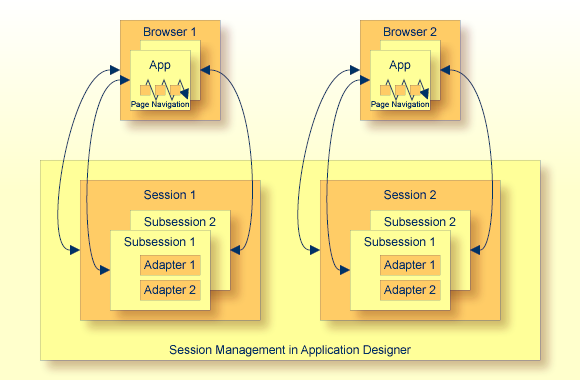You might ask: who controls the life cycle of the adapter classes? If I navigate from page "A" to page "B" and go back to page "A": do I come back to the adapter object I was already using, or do I get a new adapter instance?
This document covers the following topics:
The management of the adapters inside the server is done by the session management of Application Designer. Typically you do not have to take care of it - it is done automatically in front of your adapters.
Every browser instance connected to Application Designer creates a session and is assigned to it at the server side. If you start another browser instance, a second session is created internally which is completely decoupled from all other sessions. And so on.
A session is divided into subsessions. A subsession is a logical separation of independent activities which run parallel within the context of one session. Example: in the workplace, you can run various applications in parallel. You can switch from one application to the other. Each running application is represented by an instance of a subsession at the server side. The subsessions are also completely isolated from each other.
Within a subsession, the adapter instances are held. The basic rules for managing these instances inside one subsession are:
For each adapter class one instance is kept. This means: if a page requests an adapter, it is first determined whether this adapter instance is already created within the subsession. If yes, the existing instance is used, otherwise a new adapter instance is created and registered.
The adapter instance is held for the whole life cycle of the subsession - as long as not explicitly removed by the adapter logic.
All variant and page navigation is done inside a subsession as described in this section.

Page navigation within the browser is a navigation between adapter instances of the same subsession.
The final garbage collection of adapter instances is done by removing a
subsession - if not explicitly controlled in a different way by the adapter
logic. The adapter class offers the method
endProcess() which removes the subsession you are just
working with:
public void exit()
{
// check if you really want to exit
if ( ... )
{
...
this.outputMessage("E","Cannot exit due to...");
return;
}
// exit
this.endProcess();
}
Whenever a user logs off, the session - including all subsessions and its assigned adapter instances - is removed from the session management and released for garbage collection.